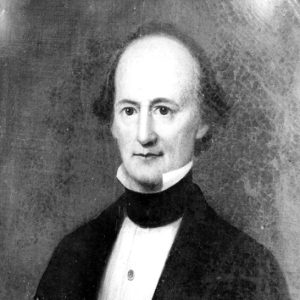calsfoundation@cals.org
Arkansas Times and Advocate
aka: Arkansas Advocate
The Arkansas Advocate was the second successful newspaper in Arkansas. It was created in direct opposition to the state’s oldest and longest-running paper, the Arkansas Gazette, in 1830 by Charles Pierre Bertrand of Little Rock (Pulaski County). While Bertrand originally intended his paper to avoid party loyalties, the Advocate (later the Arkansas Times and Advocate) favored the politics of whoever its editor was at the time. The newspaper ceased operations in 1844.
A year after Robert Crittenden mortally wounded Henry Wharton Conway on October 29, 1827, Crittenden and eight unnamed financial backers attempted to start a newspaper opposed to William E. Woodruff’s Arkansas Gazette. In the summer of 1828, Crittenden, acting for himself and as legal counsel for the seven backers, contracted with a man named Simpson. The agreement was to start a new paper in Little Rock that fall. The eight backers reportedly paid $500 each, but the deal fell through. While the venture was supposed to be secret, the Gazette managed to find out. Thinking that John Quincy Adams would be reelected as president of the United States in 1828, Crittenden submitted his name for governor of Arkansas Territory, but on April 8, 1829, newly elected U.S. president Andrew Jackson removed Crittenden from his office as secretary of the Arkansas Territory.
On November 23, 1829, twenty-one-year-old Charles Pierre Bertrand completed his apprenticeship with Arkansas Gazette founder and editor William E. Woodruff. Now a journeymen printer, Bertrand wanted to start his own enterprise. On November 3, Bertrand gave his prospectus for the Advocate to Woodruff, but Woodruff wanted no connection with it. Bertrand envisioned a paper “disavowing any connection with parties, whose infuriate zeal has for years been a reproach to our country and retarded her growth,” adding that “the Advocate shall be open to all parties and be devoted to none.” Woodruff’s Gazette was, at least on the surface, politically neutral, as it did not openly endorse candidates for either political party. Instead, Gazette columnists used false names to hide their identities from the public. Bertrand also pledged to allow religious communications from any Christian denomination, which the Gazette did not under William Woodruff’s editorship.
After Bertrand was released from his apprenticeship with Woodruff, he went to Cincinnati, Ohio, to purchase supplies needed to begin printing the Arkansas Advocate. Bertrand’s first issue appeared on March 31, 1830, on a super-royal sheet, the same size the Gazette used. On the front page, Bertrand declared “with respect to the Editor of the Gazette, I hesitate not to say, that the many favors received from him, during an intimate acquaintance of several years, demand my warmest gratitude—and so far, as may be consistent with my duties as Editor of an independent paper, I will cultivate his friendship. If collisions unhappily arise between us, it must begin with him.” Afterward, the Advocate and the Gazette went to war.
In 1830, Woodruff published an editorial in the Gazette by someone using the name “Jaw-Bone,” which was the first accusing Bertrand and the Advocate of being controlled by “a certain gentleman,” Robert Crittenden. Bertrand denied the allegations and declared himself sole owner of the Advocate. Later, “Jaw-Bone” said the press and materials were probably purchased in Bertrand’s name but with Crittenden’s money. Bertrand neither confirmed nor denied these allegations. Bertrand kept up the battle with Woodruff’s Gazette from 1830 until 1835, when he seized the opportunity to sell the Advocate to Albert Pike for the reported sum of $2,500. Pike took control of the Advocate as its proprietor and editor after his wife, Mary Ann Hamilton Pike, had inherited a large fortune, assuming the new office on January 20, 1835.
The Advocate became Pike’s—and by extension the Whig Party’s—mouthpiece from the moment he replaced Bertrand as its editor. Pike’s opinions appeared in every issue under the headline “The Editor’s Table.” Under Pike’s leadership, the Advocate covered the fight for Arkansas’s statehood, the Texas Revolution of 1835–36, and the creation of the state’s first banking system. While acting as the paper’s editor and financial backer, Pike left the actual running of the weekly paper and printing of each issue to his two apprentices, Charles E. Rice and Archibald Coulter, the latter of whom became Pike’s partner in February 1837. By then, however, Pike wanted to rid himself of the paper so that he could focus on his law practice. Pike’s solution was to merge the Advocate with a smaller and like-minded newspaper, John Reed’s Times. Reed accepted, and on April 29, 1837, a joint statement was published in the Advocate explaining why the two papers had merged. Pike called himself “senior editor” of the new Arkansas Times and Advocate, but Reed would “take charge of the business department” as editor. Pike continued writing for the paper but no longer was responsible for its day-to-day activities.
In July 1838, John Reed sold his interests in the Times and Advocate to two fellow Whigs, Eli Colby and Michael J. Steck. However, differences of opinion between Colby and established Arkansas Whigs like Albert Pike and William Cummins led to a schism between them. Historian Walter Lee Brown said that Cummins and Pike believed Colby was “not vigorous enough” in the local Whig cause, so they wanted him removed as editor of the paper. Pike wanted as editor David Lambert, a fellow Whig and lawyer who had opened his practice in Little Rock on April 1, 1839. Lambert had worked for the New York Evening Star under editor Mordecai Manuel Noah. Pike and Cummins formed a committee and offered to purchase half of the controlling interest in Colby’s Times and Advocate. Colby refused their offer, and Arkansas Whigs, including Pike, Cummins, and Bertrand, furnished Lambert enough money to start his own paper, the Arkansas Star. The new paper was short lived, as a tornado that struck on June 6, 1840, left the Star office badly damaged. Lambert supposedly fled shortly afterward. Cornelius Stone and Samuel McCurdy resumed printing the Star by the end of June. Colby alleged in July 1840 that Lambert, his rival, had retired, leaving the Star “minus four or five thousand dollars.” Now, the Times and Advocate had a new rival publication.
By 1842, the Arkansas Star was out of business, leaving Eli Colby’s Times and Advocate as the state’s sole Whig newspaper. That year, with the Arkansas State Bank’s and Real Estate Bank’s failures, Colby used his paper to promote a “union movement” of farmers and merchants who would nominate candidates unconnected to either bank to help bring an end to the state’s financial crisis. But it backfired; according to Walter Lee Brown, Colby’s movement resulted in a revolt of “anti-bankites” against leaders of both parties.
In October 1842, both the Gazette and the Times and Advocate were indirectly involved in a counterfeit scandal involving Little Rock mayor Samuel G. Trowbridge. Trowbridge had hired Francis M. Van Horne of the Gazette in 1839 and the foreman of the Times and Advocate in 1841 to print counterfeit bank notes using his own printing press by stealing pieces of type from the Advocate office. In 1842, Van Horne and Thomas Sterne, both Trowbridge Gang members, moved to Van Buren (Crawford County), where they founded the Arkansas Intelligencer. The fake notes were used by the Trowbridge Gang until 1843, and Van Horne was eventually sentenced to six years and six months in the state penitentiary for his role.
Times and Advocate editor Eli Colby died from “consumption” (tuberculosis) on March 15, 1844. Cyrus Weller was hired as editor a few days later. Weller, a Democrat, turned the paper back into a mouthpiece for the Arkansas Democratic Party. Under Weller, the paper endorsed Martin Van Buren for president that year. But the Times and Advocate did not survive the year. The last issue was printed on September 30, 1844, announcing Weller’s termination as editor and his intention to leave Arkansas. Weller took his family to Covington, Tennessee, where the twenty-five-year-old died of an inflammation of the lungs on December 10, 1844. The paper suspended publication afterward under a heavy mortgage. John Colby (brother of Eli) and Jacob Gish tried to launch the Arkansas Farmer and the Spirit of the Age from the former Times and Advocate office, but neither were successful.
For additional information:
Brown, Walter Lee. A Life of Albert Pike. Fayetteville: University of Arkansas Press, 1997.
Ross, Margaret. Arkansas Gazette: The Early Years 1819–1866. Little Rock: Arkansas Gazette Foundation, 1969.
Cody Lynn Berry
Benton, Arkansas
 Louisiana Purchase through Early Statehood, 1803 through 1860
Louisiana Purchase through Early Statehood, 1803 through 1860 Mass Media
Mass Media Charles Bertrand
Charles Bertrand 




Comments
No comments on this entry yet.